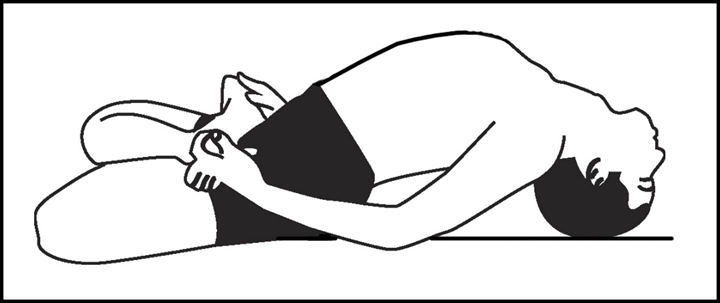Matsyasana (Fish Pose)

Preparation
- Sit in padmasana (lotus pose) and relax your entire body.
Main Pose
- Carefully bend backward, using your arms and elbows to support your body.
- Lift the chest slightly, arch the back, and gently lower the crown of your head to the floor.
- Hold onto your big toes and rest your elbows on the floor.
- Adjust your head position to achieve the maximum arch in your back.
- Relax your arms and legs, allowing them to bear the weight of your body.
- Close your eyes and breathe slowly and deeply.
- To return, reverse the movements and come back to the starting position. Cross your legs the other way around.
Breathing
- Breathe deeply and slowly while in the final position.
Duration
You can hold the final position for up to 5 minutes, but 1 to 3 minutes is generally sufficient.
Awareness
- Physical awareness on the abdomen, chest, neck, and breath.
- Spiritual awareness on manipura (navel) or anahata (heart) chakra.
Sequence
- Ideal complementary poses are halasana or setu bandhasana as they stretch the neck in the opposite direction, releasing muscular tension.
Contraindications
Avoid if you have heart disease, peptic ulcers, hernia, serious back conditions, or any severe medical issues.
- Pregnant women should not attempt this pose.
Benefits
- Stretches the intestines and abdominal organs, beneficial for abdominal ailments.
- Relieves constipation; drinking 3 glasses of water before practicing can enhance its effects.
- Helps with inflamed and bleeding piles.
- Beneficial for asthma and bronchitis by encouraging deep respiration.
- Improves circulation in the back, reducing backache.
- Regulates thyroid function and stimulates the thymus gland, boosting immunity.
- Provides a pelvic stretch and redirects blood circulation from the legs to pelvic organs, promoting vitality.
Practice Note
- Lower and raise the body into and from the final position slowly, using the elbows for support.
- Exercise caution and control, as improper movements can lead to spine injuries.
Additional Note
- The leg folding in matsyasana resembles a fish’s tail, while the body and head represent the rest of the fish’s form.
